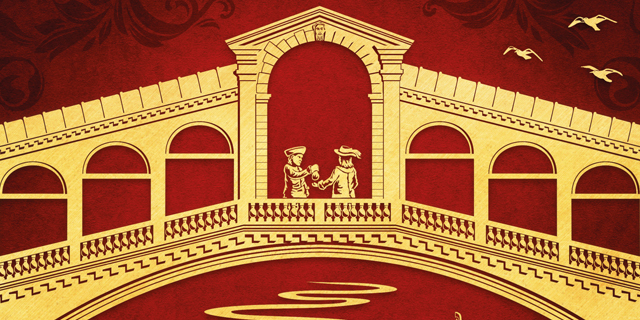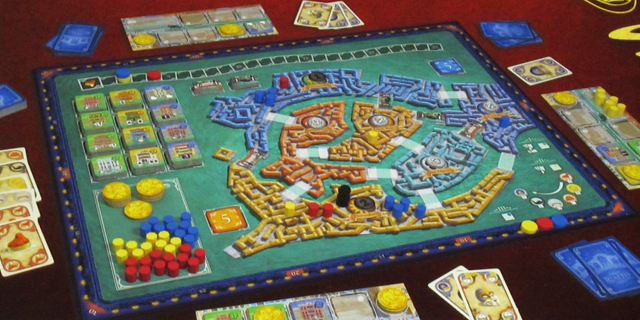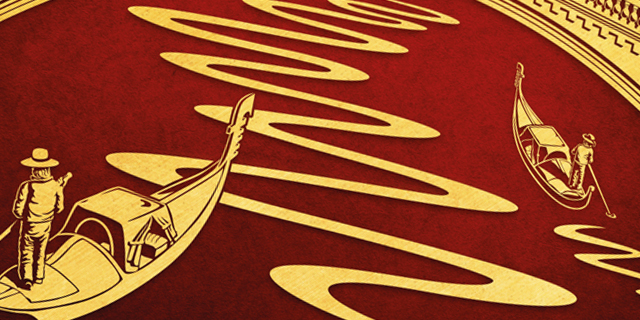
Stefan Feld is having a crazy 2013, with four new titles hitting shelves this year. One of these, Rialto, is an elegant card-driven design for two to five players. Rialto, published in the U.S. by Tasty Minstrel Games, plays out over six rounds, with each round having three phases. The first phase features players selecting a hand of cards from a number of face-up rows of six, then drawing two additional cards from the deck before discarding one. This hand of seven cards will be played out during phase two, which is where most of the action happens.
Phase two has six steps, with each step corresponding to a specific type of card. Players play out as many of the specified card as they wish, receiving a corresponding benefit for each one played. The player who plays the most cards receives a bonus, usually an additional reward over the number of cards played. Doge cards advance players on the doge track; positioning on this track determines start player but more importantly decides who wins ties. Merchant cards provide coins, which are used to activate the buildings you earn with Architect cards. Bridge cards earn points – and cost you a point if you fail to play at least one. In addition to a bonus point, whoever plays the most Bridge cards gets to place one of the six bridge tiles on the board, which will play a large part in determining the value of each district at the end of the game.
Gondola cards award councilmen from the general supply, and the bonus of both placing a gondola tile and putting a councilman into one of the connected districts directly from the general supply (instead of receiving an extra one to your personal supply). This is the only way to place councilmen outside of the final phase (with Council cards, obviously), as well as the only way to place one in a district outside of the one for the current round. There is a final card type, Jester, which can either be used as a wild to supplement any other type or, if you have a pair of them, as any one other card.

The final phase is simply used to activate any blue buildings you have acquired over the course of the game. Other types of buildings, green and yellow, can only be activated during the first and second phases, respectively. Each building has four levels, with each one producing a different effect. Green buildings can let you draw additional cards and/or increase your maximum hand size, which will increase your options for phase two. Yellow buildings allow you to delay playing your cards, change cards into different types, or provide a virtual jester. The effects of blue buildings are powerful and usually result in gaining points in some way. Each player can only have seven buildings, but if you ever go over that limit you can turn in one you have already received and earn points equal to its level.
Other sources of points come from various sources. Any time you would receive councilmen from the general supply but have none of your color left there, you get points instead. Buildings you have at the end of the game are worth their level in points, as are half of any coins and councilmen you have left over. Five bonus points are awarded to the first player to place councilmen in the three blue districts and another for the three red districts. Finally, the player with the most councilmen in each district earns points according to the bridge and gondola tiles placed on that district; second place receives half of that total (rounded down) and third gets half of second place (again rounded down). These districts can be worth from four to twenty-three points for first place, so some huge swings are possible here. Whoever has the most points wins, with ties once again being broken by the doge track.
I really cannot overstate how subtly powerful the doge track can be. Getting first selection of the face-up cards is nice and all, but the real strength lies with winning ties. If, say, everyone plays one bridge card during phase two, then it is the leader of the doge track who not only gets the additional point but also gets to place the bridge for that round. Ties happen all the time in Rialto, including when it comes to determining councilman majority scoring. Of course, earning positioning on the doge track often comes at the expense of being able to play other cards, so choose your battles wisely.

Rialto plays quickly (about 45 minutes), as the decisions are relatively straightforward and are mostly centered around which cards you want to keep and how you want to play them out. You can even choose to not play some cards, adding any leftovers to your options for the next round, but you still must abide by whatever your maximum hand size happens to be. While it is possible to have your strategy derailed by a poor deal or draw, careful application of buildings can help get around that randomness.
If there is a noticeable flaw to Rialto, it might be the board itself. The score track is represented by yellow street lights against a midnight blue background, but the dark background makes the black posts of the lamps almost invisible. The spaces between the lights are where the score markers are supposed to go, but the temptation to place them on the lights themselves, as readily-countable “spaces,” is hard to fight. The odd shapes of the six districts can also cause some problems when it comes to placing councilmen, but this is only an issue if players over-commit.
Aesthetic decisions aside, I really like the way Rialto plays. Every one of your actions ties into another action down the road. You need gold to activate buildings, which can affect further plays. You need to play Gondola cards to get the councilmen you place with Council cards, and can also use the gondolas to sneak in an additional councilman out of sequence. Of course, your councilmen won’t be worth much if bridges aren’t placed in an advantageous manner… It really takes a balanced plan of attack to make the most out of your decisions.
Rialto retails for around $50.



















